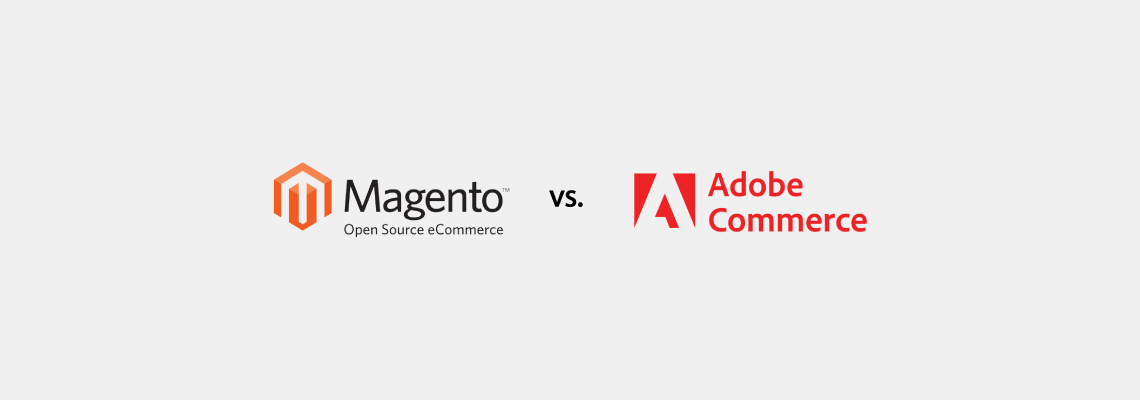Magento Open Source vs. Adobe Commerce
Lately, we have noticed that many of our customers are a bit confused about what version of Magento to choose, which one better suits their needs, so let’s have a closer look at it. Nowadays, Adobe offers two different solutions for e-commerce customers: Magento Open Source and Adobe Commerce.

A history of Magento
Magento was created in 2007, when the first beta version was released to the public. It was originally intended to be only a sub-product of the osCommerce platform. However, its features were too extensive, and so an entirely new platform was created. Magento became very popular quite quickly, so in 2009 the Enterprise edition came along. In 2011, eBay acquired a 100% stake in Magento and two years later they merged.
In 2015, Magento 2 was released. The following year, a partnership with Adobe was announced and they bought it in 2018. Magento Community Edition became Magento Open Source and Magento Enterprise Edition changed into Magento Commerce, in 2021 rebranded to Adobe Commerce.
The benefits of Magento in general
Magento has many undeniable advantages no matter which version you choose. The main advantages include the fact that it is:
- Flexible
- Scalable
- Globally usable
- Customizable
- PWA friendly (by the way, check our StoreFront X PWA for Magento)
It is an ideal solution for all business models (B2C, B2B, D2C, etc.), using omnichannel marketing strategy.
Magento Open Source (aka Magento Community Edition)
What is it?
It is a free version of a self-hosted platform that allows programmers to create an online store without additional costs such as licensing or development fees. Even though it’s for free, it’s still backed and supported by Adobe. It offers endless customization options as well as Magento Marketplace extension, which basically means that businesses can make a successful website without much cost and with great variability.
Who is it for?
If you are new to e-commerce and have a small budget, then Magento Open Source is the right platform for you. It is also suitable for small businesses or companies that sell one/several products. This is because they don’t require much customization and their main goal is to keep the business model simple and straightforward. Open source provides a global platform at a low cost, but at the same time you have to reckon with limited features.
Features
Open source has all the features and capabilities needed for small, smaller and medium-sized businesses. Additional integrations or extensions can always be added if needed. Moreover, a skilled developer can help them create a solution tailored to their exact needs. It now includes Pagebuilder, which was only part of the Commerce version for 2 years. Here we can see great support from Adobe, even though this version is not licensed.
Built-in features:
- Integrated checkout, payment, and shipping
- Mobile optimized shopping
- Global selling
- Catalog management
- Extended functionality via App Marketplace
- Instant purchase
- Site search
- WYSIWYG Page Builder
Adobe Commerce (aka Magento Enterprise)
What is it?
This paid hosted e-commerce platform is much more supported and offers wider options. Adobe Commerce can be further divided into two versions: AC Cloud and AC On-Premise. The On-Prem version provides a comprehensive solution, and is entirely hosted in the cloud, which is probably one of the most important differences compared to open source. If you choose Adobe Commerce Cloud, you can also enjoy better security features, faster page loads, better time to market and full support from the beginning.
Who is it for?
This e-commerce platform is suitable for medium and large enterprises. Using Adobe Commerce gives you a wider range of features and better security. Not that open source can’t do it, but it would require a lot more effort and customization to achieve it.
It supports B2B e-commerce, which Magento Open Source does not allow (you can use add-ons and customizations, but it is always a small piece, not a whole module that solves all problems). In contrast, B2B e-com is comprehensive and covers the entire process from the needs of the company to customized pricing and services. So, if you’re planning to build a large, scalable platform, Adobe Commerce is right for you.
Features
Besides all the features from the open-source version, Magento Commerce offers plenty of additional tools. And many more are yet to come, because Adobe is gradually integrating its other services into Commerce. Current features include:
- Magento BI
- B2B functionality
- Advanced marketing tools
- Customer segmentation and loyalty tools
- Staging and preview of content
- Visual merchandising
- Adobe Sensei (AI for e-com)
- Recommendation / Search / Visual Search
- Performance monitoring tools
- And many more
The comparison of all the features that each version offers can be seen on the picture below.
How to decide
Adobe says: „Magento Open Source delivers all the basic ecommerce capabilities and allows you to build a unique online store from the ground up.“ It is a good choice if you are a start-up, a smaller business or a business with one/several products.
If your store handles hundreds of visitors and orders a day, Adobe Commerce will be a better option for you, because you get a fully featured cloud-based ecommerce solution. With a license, you’ll get full support from the Adobe team, along with lots of built-in tools that will make your job a lot easier.
Still not sure which one to choose?
Still not sure which one to choose? We’re here for you! Just contact us using the form below and together we will find the perfect fit for you.
